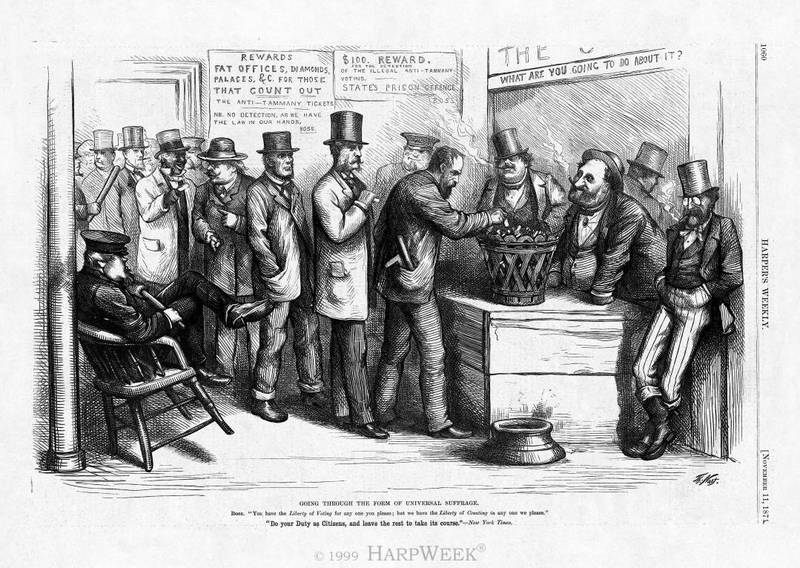"Going Through the Form of Universal Suffrage"
By Schuyler Edmondson
The main topic in the cartoon “Going Through the Form of Universal Suffrage,” is voting fraud. Thomas Nast created this cartoon and it was published in Harper’s Weekly in 1871. The cartoon is rather busy, and there are many things to make note of if you examine it closely. The first thing you will notice is the line of men appearing to be of different ethnicities. The 15th amendment had already been enacted in 1871, so men of every race could legally vote. There are white men, black men, and men of Irish descent preparing to cast their ballots. If you look closely at the men’s facial expressions, you will notice the African American man is the only voter who appears to be jolly. He celebrates his right to vote even though it may not be counted. While examining the voters, you will also see that the current voter has a gun in his pocket. The voting polls could be a dangerous place during this era, and many men found it necessary for their own safety to bring weapons as means of protection. The votes are being placed into a waste basket, symbolizing that they will be thrown away or not counted, “trash” in the Democrats eyes.
Another important factor in the cartoon is the presence of policeman. There are four policemen between the hallway and the room, with some holding clubs. Though they are supposed to be at the voting sight to ensure justice and a fair vote, the most noticeable policeman is leaned back in his chair, appearing not to pay attention in the slightest. The policeman on the back wall is smiling, a sign that he does not plan to do anything to stop the Democrats from counting the votes as they see fit.
The caption reads:
“Boss: “You have the Liberty of Voting for any one you please; but we have the Liberty of Counting in any one we please.”
“Do your Duty as Citizens, and leave the rest to take its course.”
“Boss” refers to William Tweed, the boss of Tammany Hall which was a Democratic Party political machine. He is seen smoking against the wall in the back in a top hat. He has a rather smug look on his face, most likely because he knows he is in control of this voting poll. Another key figure is Peter Sweeny, the park commissioner of that time. He is the large man leaning on the desk, also smoking. He looks out into the crowd with a grin, because he also knows that he plays a role in who will win this election. Mayor Hall is also in the cartoon, fitting because the man in charge of the town should be willing and able to enforce the laws of justice. However, he is seen leaning back against the wall beside the desk, also smoking. His demeanor portrays carelessness. With his hands in his pockets and his legs crossed, he is in no position to govern anything or anyone. The shadowy form in the back is supposed to be Richard Connolly, chief financial officer. His back is turned, symbolizing his unawareness of the votes being counted unfairly.
The wording on the doorway above the receptacle cannot be seen, but it is assumed to say “The Count” with “What are you going to do about it?” underneath. Nast uses this to show that though citizens had the right to vote, they could not guarantee that their vote would be counted. In this depiction, the Democrats are in charge of the poll and will count the votes as they so please. There are also several signs on the wall that display rewards for those who “count out the anti-Tammany tickets” by offering monetary rewards. This further adds to the point that Nast is trying to make referring to how crooked voting polls were during this time. Money and power should not have been an influence to voters. They should have been allowed the freedom to vote for who they believed would serve their county, state, and country well. However, many in charge took that freedom away by stuffing ballots, intimidating voters, and miscounting ballots.
Nast accurately displays what voting was like in 1871 by his cartoon “Going Through the Form of Universal Suffrage.” No matter what race, ethnicity, or previous servitude defined you, your vote may not be counted. Your opinion may not matter. Even today, your world may be controlled by someone with opposing views, but having the right to a fair vote makes a big difference in how people react on Election Day.
Bibliography:
Adler, John, and Draper Hill. Doomed by Cartoon: How Cartoonist Thomas Nast and the New-York Times Brought down Boss Tweed and His Ting of Thieves. New York: Morgan James Publishing, 2008. 165.
Nast, Thomas. "Going Through the Form of Universal Suffrage." Harper's Weekly, November 11, 1871. 1060. Accessed April 16, 2015. http://app.harpweek.com.prox.lib.ncsu.edu/IssueImagesView.asp?titleId=HW&volumeId=1871&issueId=1111&page=1060
